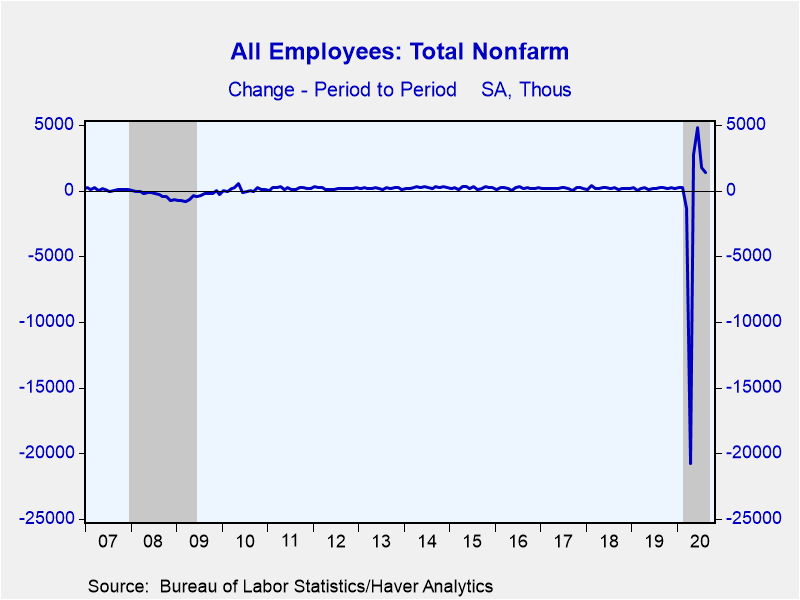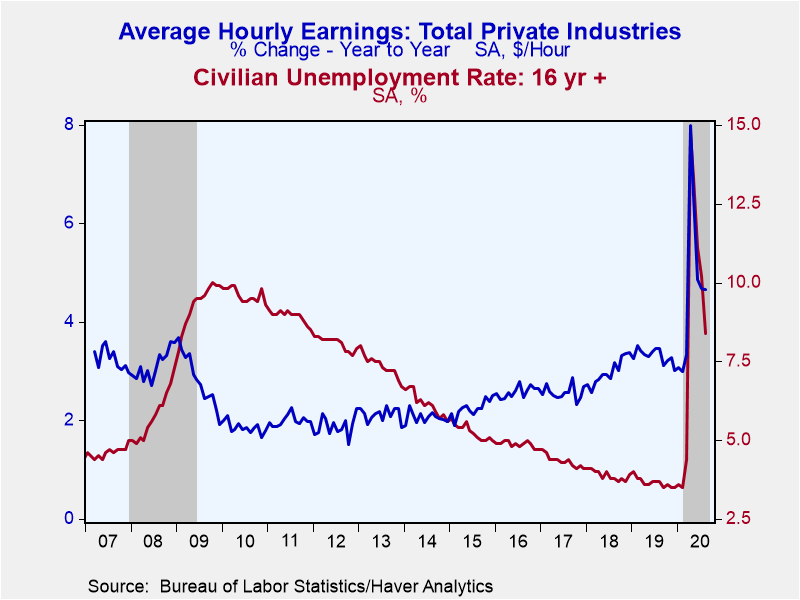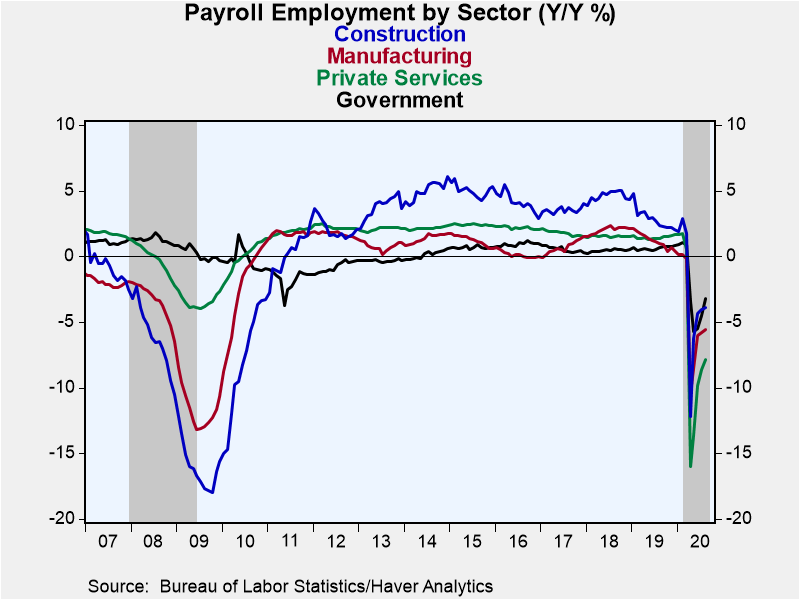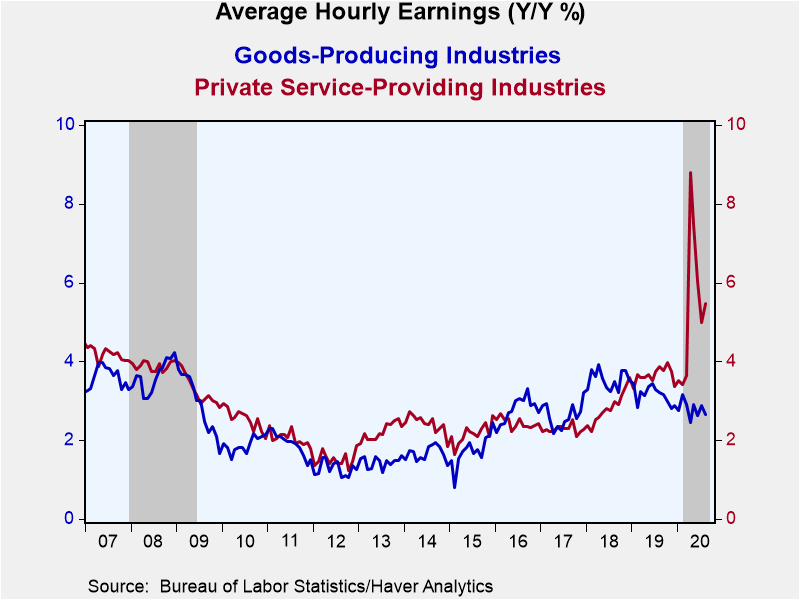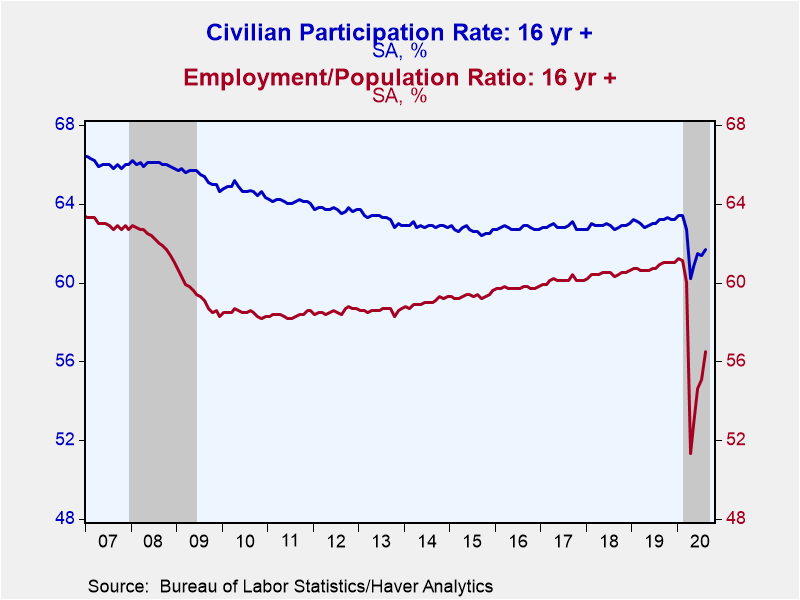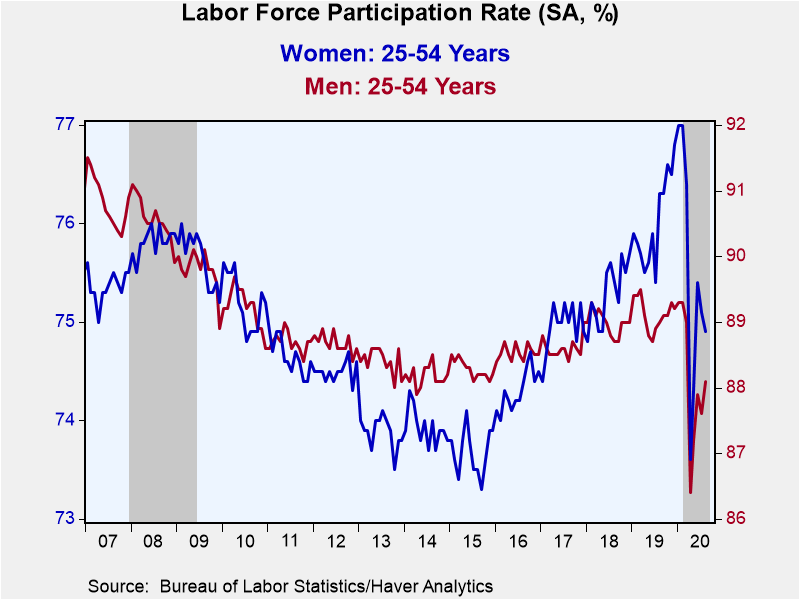 Global| Sep 04 2020
Global| Sep 04 2020U.S. Employment Growth Remains Firm in August; Earnings Growth Picks Up & Jobless Rate Falls Sharply
by:Tom Moeller
|in:Economy in Brief
Summary
• Strong job gains continue after coronavirus shutdowns ebb. • Census hiring boosts total. • Earnings growth improves. • Jobless rate declines to five-month low. Labor market healing is continuing. Nonfarm payroll employment increased [...]
• Strong job gains continue after coronavirus shutdowns ebb.
• Census hiring boosts total.
• Earnings growth improves.
• Jobless rate declines to five-month low.
Labor market healing is continuing. Nonfarm payroll employment increased 1.371 million in August (-7.0% y/y) after rising 1.734 million in July, revised from 1.763 million. June employment improved 4.781 million, revised from 4.791 million. Job growth has been positive for four consecutive months following sharp declines in the prior two months during the economic recession. A 1.395 million employment increase had been expected in the Action Economics Forecast Survey. The estimates amongst 24 forecasters had ranged from 435,000 to 2 million.
Average hourly earnings growth picked up to 0.4% (4.7% y/y) after a 0.1% July gain, revised from 0.2%. No change in earnings had been expected.
The unemployment rate fell to 8.4% from 10.2%. An easing to 9.9% had been expected. Employment in the household survey increased 3.756 million after rising 1.350 million in July while the labor force rose 968,000 after falling 62,000 in July. The overall jobless rate, including those who were marginally attached or working part-time for economic reasons, declined to 14.2% from 16.5%.
The 1.371 million job gain in the payroll survey still left the number of jobs 11.6 million below the February peak. It reflected a 29,000 increase (-5.6% y/y) in factory sector payrolls, which was the fourth consecutive monthly improvement. Construction sector employment rose 16,000 (-3.9% y/y) in August following a 27,000 rise in July. Employment in the mining & logging sector fell 2,000 (-16.0% y/y).
Private service sector jobs increased 984,000, reflecting a 341,000 increase in trade, transportation & utilities jobs (-4.5% y/y). Professional & business services employment rose 197,000 (-6.0% y/y) including a 106,700 surge (-16.1% y/y) in temporary help. Leisure & hospitality employment rose 174,000 (-28.2% y/y) and education & health care jobs improved 147,000 (-4.9% y/y). The number of financial activities jobs increased 36,000 (-1.4% y/y) and information sector employment rose 15,000 (-10.1% y/y).
Government sector employment increased 344,000, reflecting a 238,000 addition to federal payrolls from Census workers. State government payrolls fell 2,000 (-3.9% y/y) and local government payrolls rose 95,000 (-5.7% y/y).
Average hourly earnings improved 0.4% in August, reflecting 0.5% rise in factory sector pay which raised the y/y change to 4.0% from a low of 1.7% during all of 2018. Construction sector earnings rose 0.3% (3.3% y/y). Private service sector earnings improved 0.3% (4.9% y/y) as leisure & hospitality earnings rose 0.7% (2.3% y/y) which was a rebound from July's 0.6% decline. Financial activities earnings also rose 0.7% (5.0% y/y) after falling 0.3%. Professional & business service sector earnings rose 0.4% (3.9% y/y) but information sector earnings eased 0.1% (+3.0% y/y) after strengthening 1.8% in June.
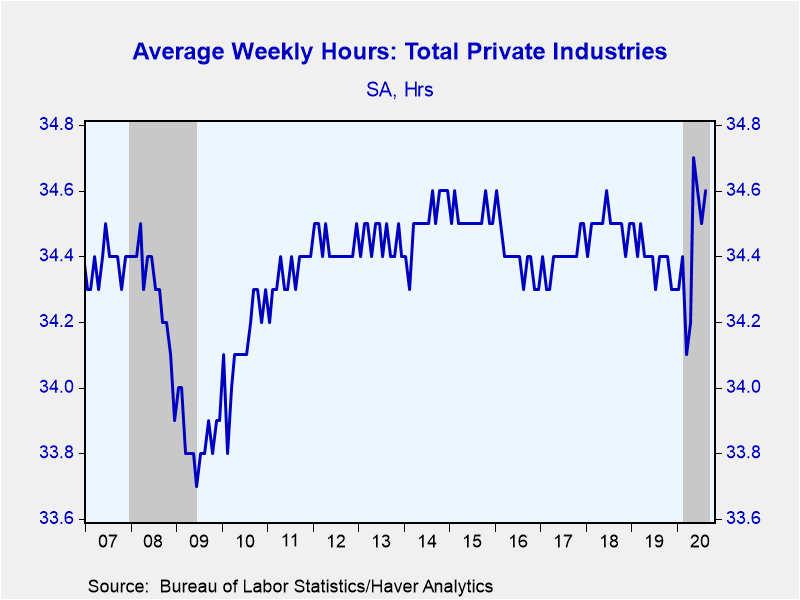 The length of the average workweek lengthened to 34.6 hours
last month and recovered the July decline. Mining & logging hours rose to
44.0 but that remained below the 1999 average of 46.2 hours. Factory sector
hours rose to 40.0 and construction gained to 38.9 hours. The length of the
private service sector workweek improved slightly to 33.6 hours as financial
sector hours were steady at 37.5 and information sector hours rose to 36.6.
Trade, transportation & utilities hours rose to 34.1. The length of the
education & health services workweek eased to 33.3 hours while leisure &
hospitality hours improved to 25.8.
The length of the average workweek lengthened to 34.6 hours
last month and recovered the July decline. Mining & logging hours rose to
44.0 but that remained below the 1999 average of 46.2 hours. Factory sector
hours rose to 40.0 and construction gained to 38.9 hours. The length of the
private service sector workweek improved slightly to 33.6 hours as financial
sector hours were steady at 37.5 and information sector hours rose to 36.6.
Trade, transportation & utilities hours rose to 34.1. The length of the
education & health services workweek eased to 33.3 hours while leisure &
hospitality hours improved to 25.8.
From the household survey, the decline in the unemployment rate to 8.4% occurred as the labor force participation rate rose m/m to 61.7%, its highest level since March, but remained down from 63.4% just before the recession began. The teenage participation rate rebounded to 33.9% after falling sharply in June and for those aged 20-24, it improved to 68.2%, a five-month high. For workers aged 25-54, the rate edged higher m/m to 81.4%, up from a low of 79.9% in May. For men aged 25-54, the rate rebounded m/m to 88.1% but remained down from 89.3% six months earlier. For women of that age, the rate declined to 74.9% and remained well below its February record high of 77.0%. For workers aged 55 & over, the participation rate improved to 39.4%.
The employment/population ratio for all workers rose to 56.5%, up from April's low of 51.3%. It remained sharply lower than January's high of 61.2%. The average duration of unemployment rose to 20.2 weeks, up from 6.1 weeks in April.
The teenage unemployment rate fell sharply to 16.1% from 19.3%. It remained below the record 31.9% in April but still much higher than February's 11.0%. The rate for workers aged 20-24 fell to 14.1%, down from the April record of 25.7%. For workers aged 25-54, the rate declined m/m to 7.5%, down from the 12.8% April high. For those over 55, the jobless rate declined to 7.7% and was below the record 13.6% in April.
By educational attainment, unemployment of workers without a high school diploma was 12.6% in July, down from 21.2% in April. High school graduates without any college were 9.8% unemployed last month, down from April's high of 17.3% but higher than 3.6% in February. Those with some college but no degree were 8.0% unemployed, down sharply from the 15.0% April peak but still up from December's near-record low of 2.7%. College graduates were a reduced 5.3% unemployed. That still was increased from a 1.9% low in February.
The employment & earnings data are collected from surveys taken each month during the week containing the 12th of the month. The labor market data are contained in Haver's USECON database. Detailed figures are in the EMPL and LABOR databases. The expectations figures are in the AS1REPNA database.
| Employment (SA, M/M Change, 000s) | Aug | Jul | Jun | Aug Y/Y | 2019 | 2018 | 2017 |
|---|---|---|---|---|---|---|---|
| Payroll Employment | 1,371 | 1,734 | 4,781 | -7.0% | 1.4% | 1.6% | 1.6% |
| Previous Estimate | -- | 1,763 | 4,791 | -- | -- | -- | -- |
| Manufacturing | 29 | 41` | 333 | -5.6 | 1.2 | 2.0 | 0.7 |
| Construction | 16 | 27 | 159 | -3.9 | 2.8 | 4.6 | 3.6 |
| Private Service-Producing | 984 | 1,420 | 4,244 | -8.0 | 1.5 | 1.5 | 1.8 |
| Government | 344 | 253 | 52 | -3.6 | 0.6 | 0.5 | 0.4 |
| Average Weekly Hours - Private Sector | 34.6 | 34.5 | 34.6 | 34.4 | 34.4 | 34.5 | 34.4 |
| Private Sector Average Hourly Earnings (%) | 0.4 | 0.1 | -1.3 | 4.7 | 3.3 | 3.0 | 2.6 |
| Unemployment Rate (%) | 8.4 | 10.2 | 11.1 | 3.7 | 3.7 | 3.9 | 4.3 |
Tom Moeller
AuthorMore in Author Profile »Prior to joining Haver Analytics in 2000, Mr. Moeller worked as the Economist at Chancellor Capital Management from 1985 to 1999. There, he developed comprehensive economic forecasts and interpreted economic data for equity and fixed income portfolio managers. Also at Chancellor, Mr. Moeller worked as an equity analyst and was responsible for researching and rating companies in the economically sensitive automobile and housing industries for investment in Chancellor’s equity portfolio. Prior to joining Chancellor, Mr. Moeller was an Economist at Citibank from 1979 to 1984. He also analyzed pricing behavior in the metals industry for the Council on Wage and Price Stability in Washington, D.C. In 1999, Mr. Moeller received the award for most accurate forecast from the Forecasters' Club of New York. From 1990 to 1992 he was President of the New York Association for Business Economists. Mr. Moeller earned an M.B.A. in Finance from Fordham University, where he graduated in 1987. He holds a Bachelor of Arts in Economics from George Washington University.


